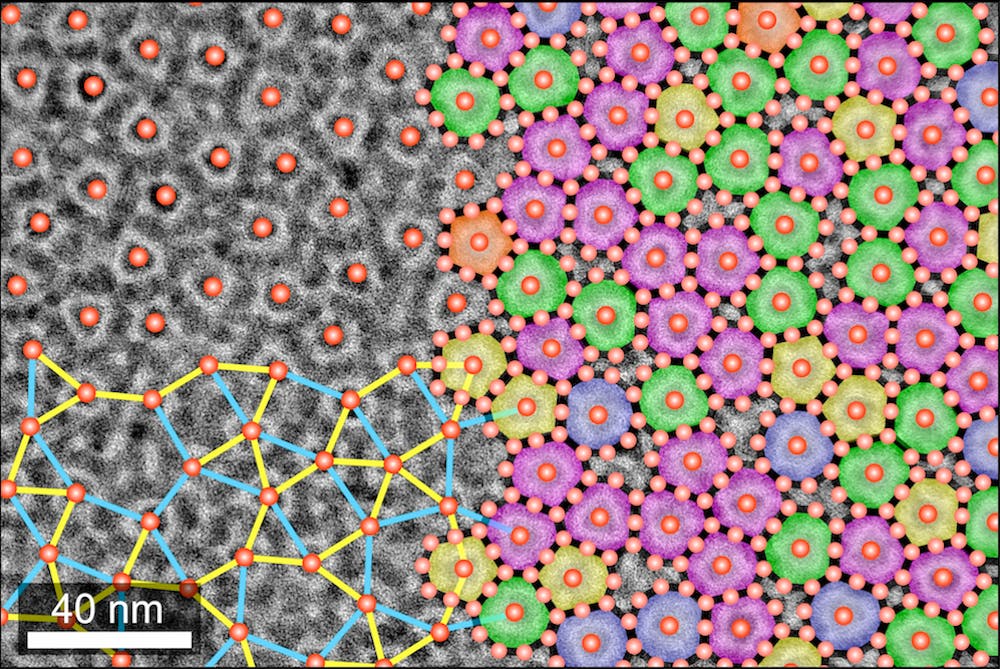When Assistant Professor of Chemistry Ou Chen and his team set out to study the structures formed by tetrahedral building blocks, they instead stumbled across an entirely new quasicrystalline structure.
In a December 2018 paper, these researchers described how their tetrahedral building blocks — a block also known as a triangular pyramid — unexpectedly “self-assembled” into quasicrystals, a discovery first noticed by post-doctoral research associate Yasutaka Nagaoka, the paper’s lead author. A quasicrystal is a physical structure comprised of building blocks that do not align in traditional crystalline patterns.
Though the discovery of this particular new quasicrystal structure was a “happy accident,” the applications of this research span the fields of chemistry, math, pattern design and art.
“People already have this type of pattern in their art. Their glass designs actually use a quasicrystal, but they don’t actually know that they’re quasicrystals, only that they have 5-fold symmetry,” Chen said.
Quasicrystals are also widely used in frying pans and other cookware because of their high thermal conductivity.
The crystals have ordered patterns with five-, ten- or twelve-fold symmetries that do not repeat and “should not exist in conventional crystallography,” Chen said, the study’s senior author. “There’s no repeating unit to fill a space. They only have rotational symmetry,” he added. “You can always use a square to fill a two-dimensional space without gaps. But you cannot use a pentagon to fill a space without gaps.”
The researchers originally set out to investigate what happens when tetrahedral nanoparticles are packed tightly together. “We never designed this project around discovering a quasicrystal,” Chen said. The team chose to use the tetrahedron as a building block because it is the most simple shape aside from the sphere.
“One day, Yasutaka was really excited to see this irregular symmetry from an electron diffraction pattern, (and) that is how we made this discovery,” Chen said.
The existence of quasicrystals was thought to be impossible prior to materials scientist Dan Shechtman’s 1982 discovery of the structures. Before his discovery, materials scientists and chemists alike thought materials could only consist of traditional crystalline structures with periodically repeating units. These units typically take the form of squares and triangles, among others. All other crystalline structures, including those with pentagons, were considered by scientists to be “forbidden.” Shechtman was awarded the 2011 Nobel Prize in Chemistry for his groundbreaking work.
“Looking at nanocrystals, we know that (they) can be self-assembled without any human inventions,” Nagaoka said. These crystals self-assemble as a result of inter-particle interactions and not because of any outside intervention.
In the case of this research, a quasicrystalline lattice with 10-fold symmetry and decagonal — ten-sided — shape self-assembled from the tetrahedral building blocks used by the researchers.
“We do expect more structures from this tetrahedron. That’s definitely one direction we’re still exploring. Also, we are trying to make this building block more complicated,” said Hua Zhu GS, a co-author of the paper. Because quasicrystals are a relatively new field in materials research, these scientists are looking to pioneer work investigating a number of the crystals’ properties. “Because quasicrystals have unique structures, they probably have unique optical and chemical properties, which will further their potential application in the future,” Chen said.
The team believes the research applications span multiple fields and disciplines. “What we propose in the paper is not only for chemists, but also for researchers in many fields, such as math, and for people who are not in science, such as artists. That is something we are proud of,” Nagaoka said.
Touching on potential future applications of quasicrystals, Chen said that “there will be a lot more to discover because this work is very underdeveloped. More research needs to be done with quasicrystals.”





